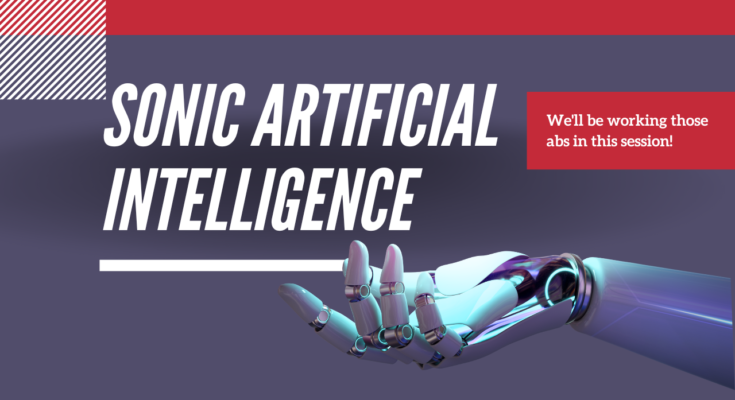Sonic Artificial Intelligence and the Evolution of Virtual Realities
Introduction:
In today’s rapidly evolving world of technology, artificial intelligence (AI) keeps pushing boundaries beyond our previous imaginings. One of the latest, remarkable, and thrilling breakthroughs in this field is Sonic AI. This innovative method combines Sonic the Hedgehog’s speed and effectiveness with the capabilities of artificial intelligence. This surprising merger of seemingly unrelated concepts heralds the beginning of a new age in AI innovation, with the potential to transform our interactions with and use of artificial intelligence.

The Need for Speed:
Sonic Artificial Intelligence is inspired by the well-known video game character Sonic the Hedgehog, who is noted for his incredible speed and ability to navigate difficult terrain. In the same spirit, Sonic AI seeks to improve the processing speed and efficiency of AI systems, addressing a significant difficulty in the industry.
Unlike traditional AI models, which can require significant computational resources and time for data analysis and interpretation, Sonic AI seeks to overcome these limits. It accomplishes this by implementing cutting-edge algorithms and approaches that prioritize speed without sacrificing accuracy.
Key Features of Sonic Artificial Intelligence:
1. Speed Optimization:
Consider whether your computer could equal Sonic the Hedgehog’s speed. Sonic AI promotes speed, allowing AI systems to process and evaluate massive amounts of data in real time. This is critical in fields such as driverless vehicles, financial trading, and healthcare, where quick decision-making is required. Sonic AI ensures the ability to act instantly becomes a central focus.
2. Efficient Resource Utilization:
In traditional AI, heavy computational demands often create obstacles, limiting accessibility and scalability. Sonic AI changes the game by optimizing resource usage, eliminating these constraints. This optimization not only streamlines processes but also makes AI more accessible across various applications and industries. Sonic AI guarantees that the potential of artificial intelligence is within reach, free from the shackles of resource limitations.
3. Adaptability:
Sonic AI seamlessly integrates into many areas and industries, much like Sonic does with different terrains and difficulties. Its adaptability is visible as it solves complex difficulties across multiple sectors, demonstrating that the future of AI is dependent on its ability to navigate and flourish in continuously changing technical settings.
4. Enhanced User Experience:
Similar to Sonic’s agility enhancing gameplay, Sonic AI transforms the user experience in applications like natural language processing, image recognition, and virtual assistants. Sonic AI’s speed and efficacy foster a responsive and dynamic relationship between users and AI systems. This breakthrough not only improves productivity, but it also opens up new prospects for collaboration between people and AI, resulting in a more intuitive and engaging contact with artificial intelligence.

Sonic Artificial Intelligence is not just about making AI faster; it’s about crafting a future where AI seamlessly integrates into our lives, adapts to our needs, and enhances our experiences in ways we could only imagine. As we ride the Sonic AI wave, the boundaries of what AI can achieve are redefined, promising a future where speed, efficiency, and adaptability are the cornerstones of the AI revolution.
Applications of Sonic Artificial Intelligence:
1. Autonomous Systems:
Picture a reality where cars, drones, and robots have the ability to make instant decisions, significantly enhancing both safety and performance.
Sonic AI’s unique speed enhancement is like giving these autonomous systems a turbo boost. Sonic AI ensures that these intelligent devices can navigate complex situations with unparalleled speed, making them more reliable and responsive than before.
2. Financial Trading:
Enter the exciting world of high-frequency trading, where every instant is significant. Sonic AI transforms this field by providing traders with fast information and analysis. Imagine yourself having the power to take advantage of opportunities as markets rapidly evolve, with unparalleled speed and accuracy. Sonic Artificial Intelligence not only keeps pace with the market but takes the lead, enabling traders to swiftly make decisions that could be the defining factor between success and failure.
3. Healthcare Diagnostics:
In the realm of healthcare, Sonic Artificial Intelligence’s adaptability takes center stage, particularly in rapid diagnostics and analysis of medical images. It’s similar to having a highly experienced medical professional who can quickly review and understand complex images. Sonic AI aids in disease identification, allowing healthcare workers to make timely decisions that have a substantial impact on patient outcomes.
4. Natural Language Processing:
Engaging with machines has become remarkably simple, thanks to the seamless integration of humans and technology. Sonic Artificial Intelligence’s enhanced processing speed has changed the way we engage with virtual assistants and language processing programs. It’s like conversing with a friend who responds immediately away. This not only makes human-computer interactions more efficient but also enhances the overall experience, making it feel more natural and intuitive. Sonic AI introduces a heightened level of responsiveness to language processing, making technology feel like a reliable companion.
Benefits of Sonic Artificial Intelligence:
| Domain | Benefits of Sonic AI |
|---|---|
| Entertainment | 1. Immersive Gaming: Dynamic soundscapes enhance gaming experiences. |
| 2. Quality Audio: AI-powered upscaling improves music and movie soundtracks. | |
| 3. Personalized Experience: Tailors audio to individual preferences. | |
| Healthcare | 1. Diagnostic Capabilities: Analyzes medical sound data for condition detection. |
| 2. Therapeutic Applications: AI-generated sounds for stress reduction and relaxation. | |
| Automotive | 1. Enhanced In-Car Audio: Adapts audio settings based on the vehicle’s environment. |
| 2. Safety Features: Alerts drivers to potential dangers using sound-based cues. | |
| Accessibility & Inclusion | 1. Real-time Sound Recognition: Assists individuals with hearing impairments. |
| 2. Inclusive Environment: Fosters inclusivity for people with diverse auditory needs. | |
| Personal Audio Experiences | 1. Customized Sound Profiles: Creates personalized audio experiences based on user preferences. |
| 2. 3D Audio Simulation: Simulates realistic and personalized audio environments, especially in virtual reality. |
Future of Sonic Artificial Intelligence:
The future of Sonic Artificial Intelligence holds the promise of transforming our gaming experiences, creating a more inclusive and captivating environment for players of all kinds.
- Sonic AI and IoT: expanding beyond personal gadgets to effortlessly blend with our physical surrounds. Picture entering a room where the lights adjust, the thermostat adapts, and your favorite music starts playing—all triggered by your presence and preferences, guided by Sonic AI. When integrated into the Internet of Things (IoT), Sonic AI could enable smart environments that respond to sound-based commands, offering users a smooth and instinctive interaction.
- Improved Collaboration Between Humans and Machines: As Sonic AI advances, it brings forth thrilling opportunities for communication that feels more natural and intuitive between humans and machines. While voice-activated assistants such as Siri and Alexa have set the groundwork for basic interactions, Sonic AI holds the potential to enhance this experience further. It can grasp subtle vocal cues, recognize emotions, and tailor responses to create a deeper connection. This advancement holds the promise of fostering more meaningful and dynamic exchanges with AI systems, transforming them into genuine companions in our everyday lives.

- Progress in Sonic Imaging: Sonic AI has expanded its reach beyond audio to include sonic imagery. Advanced sonic imaging technologies could have implications in medical diagnostics, environmental monitoring, and security. Sonic AI could provide a new perspective on the environment by utilizing sound waves, introducing non-invasive imaging techniques with a wide range of possible applications.
Conclusion:
Sonic Artificial Intelligence ushers in a new era of artificial intelligence, emphasizing the critical aspects of speed, adaptability, and efficiency. As we learn more about the potential of this ground-breaking technique, we discover that it will have a wide-ranging impact across industries. Sonic Artificial Intelligence has the potential to reshape the AI environment, whether by modernizing autonomous systems or affecting financial markets. It heralds the arrival of a future defined by incredible speed and agility.

